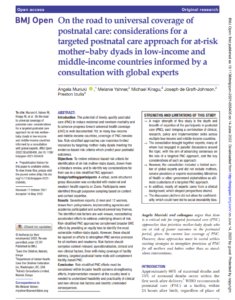
Abstract
Introduction The potential of timely, quality postnatal care (PNC) to reduce maternal and newborn mortality and to advance progress toward universal health coverage (UHC) is well-documented. Yet, in many low-income and middle-income countries, coverage of PNC remains low. Risk-stratified approaches can maximise limited resources by targeting mother–baby dyads meeting the evidence-based risk criteria which predict poor postnatal outcomes.
Objectives To review evidence-based risk criteria for identification of at-risk mother–baby dyads, drawn from a literature review, and to identify key considerations for their use in a risk-stratified PNC approach.
Design/setting/participants A virtual, semi-structured group discussion was conducted with maternal and newborn health experts on Zoom. Participants were identified through purposive sampling based on content and context expertise.
Results Seventeen experts, (5 men and 12 women), drawn from policymakers, implementing agencies and academia participated and surfaced several key themes. The identified risk factors are well-known, necessitating accelerated efforts to address underlying drivers of risk. Risk-stratified PNC approaches complement broader UHC efforts by providing an equity lens to identify the most vulnerable mother–baby dyads. However, these should be layered on efforts to strengthen PNC service provision for all mothers and newborns. Risk factors should comprise context-relevant, operationalisable, clinical and non-clinical factors. Even with rising coverage of facility delivery, targeted postnatal home visits still complement facility-based PNC.
Conclusion Risk-stratified PNC efforts must be considered within broader health systems strengthening efforts. Implementation research at the country level is needed to understand feasibility and practicality of clinical and non-clinical risk factors and identify unintended consequences.